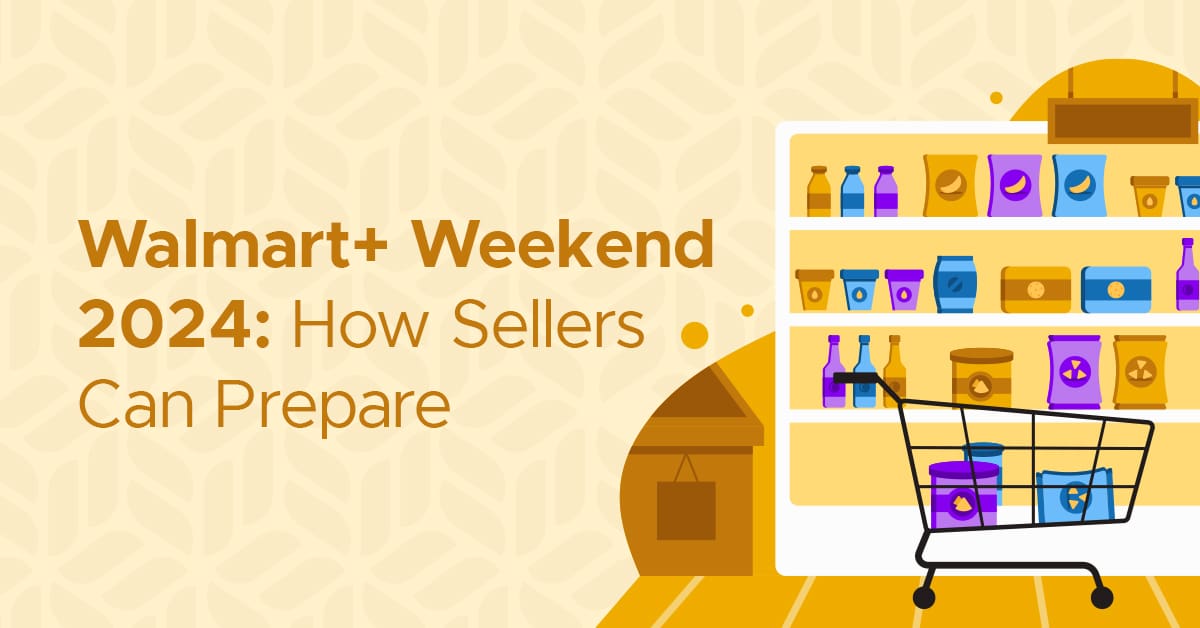
Issue 104: Freight challenges, inventory visibility, and Walmart+ Week

Hello, MyFBAPrep Sellers!
Everyone is rightfully excited about Prime Day, but don’t forget to prep for the sales boost on your other channels, too. In this newsletter we’ll share how to prepare for Walmart+ Week, common freight challenges and how to overcome them, and the benefits of inventory mapping your warehouse for better visibility.
How to Prepare for Walmart Plus Week
Walmart launched Walmart Plus in September of 2020 in the middle of the pandemic, with the program’s first sale running the weekend of June 2–5, 2022.
The event was a massive success, with the median shopping cart size surpassing the previous year’s average Walmart.com order and Prime Day shopping cart size.
In 2023, Walmart launched a second sale that coincided with the Amazon Prime Day sale. Dates were adjusted to July 10-13, running one day longer than Prime Day, so Walmart rebranded to “Walmart Plus Week” rather than just “Weekend.”
For this second event, Walmart Plus saw about only half the participation as Amazon Prime Day. Despite the less impressive turnout, though, shoppers spent considerably more, with the average shopping cart totaling $200 (compared to $126 for that year’s Prime Day).
That worked out to an estimated $10.5 billion spent during Walmart+ Week, nearly double the $5.6 billion spent on the 2022 sale.
Prepare for this boost in sales by:
- Planning your inventory
- Calculating your pricing strategy
- Setting an advertising budget
- Double checking your fulfillment capacity
- Choosing your doorbusters
Get all the details to prepare for Walmart Plus Week.
Did you know MyFBAPrep can also prep for WFS?
Use MyFBAPrep across all of your sales channels, as we can prep to your specifications for Walmart Fulfillment Services, or any other sales channel or 3PL you’d like to use.
Top Freight Logistics Challenges Businesses Are Facing & How to Navigate Them
Has freight gotten harder, or is it just you?
Well, it isn’t just you. Here are the top 3 challenges in freight, and how to address them.
1. Rising costs
Success strategy: Make long-term deals with quality partners
2. Supply chain disruptions
Success strategy: Establish a diverse network and alternate routes
3. Technology integration
Success strategy: Focus on people over tech
Read all the success strategy details on the blog.
Optimizing Manufacturing and Inventory Management With Visual Mapping
Here’s a comprehensive look at how manufacturers can introduce visual maps to hone their operations:
Map production workflow: Start by capturing the entire production workflow, from raw material intake to finished product assembly. Use the visual map to delineate each step of the process, including workstations, machinery, and material flow.
Inventory management: Track inventory levels in real time throughout the manufacturing facility with a visual map. Designate specific storage locations for raw materials, work-in-progress (WIP), and finished goods, and visually represent inventory levels.
Resource allocation: Distribute resources such as manpower, machinery, and tools more efficiently by visualizing their utilization across different production areas. Identify underutilized assets and optimize resource allocation to maximize productivity and minimize downtime.
Quality control and compliance: Implement visual checkpoints and quality control stations at critical junctures along the production line. Use the visual map to mark inspection points, testing areas, and quality assurance procedures.
Continuous improvement initiatives: Foster a culture of continuous improvement by applying visual maps to identify opportunities for refinement and innovation. Also, encourage employees to provide feedback and suggestions for enhancing processes on the visual map.
Learn how to map out your warehouse.
Top Industry News
Tips For Reducing Amazon FBA Fees (Forbes)
While the Fulfillment by Amazon (FBA) program can be a game-changer for your business, it can also become a significant cost hampering your profits. From storage to fulfillment expenses, FBA fees can quickly eat into your margins if you’re not strategic about how you use the service. Here’s how to optimize your FBA fees for Amazon success.
Mark Zuckerberg is Quietly Sitting on a Shopping Empire with 4 times the Customers of Amazon, as Facebook Marketplace Skyrockets (Fortune)
Facebook Marketplace has not only become a trusted source for LA’s second-hand scene. It’s made itself a real contender to go toe-to-toe with well-established e-commerce sites. Facebook has grown to 3.07 billion monthly active users (MAUs) as of the end of 2023, a 3% year-over-year increase. Of those, up to 40%, or 1.2 billion, are active users shopping on Marketplace, according to a March report from Capital One Shopping.
Shopify Acquires Checkout Blocks to Help Merchants Customize Checkout (PYMNTS)
The company’s app enables Shopify Plus merchants to add new fields to collect additional data or show new information to their customers, control how delivery and payment options are displayed, and design fully branded checkouts, according to the Checkout Blocks website. PYMNTS Intelligence has found that the checkout experience is decisive in building customer loyalty, with 91% of eTailers’ customers saying that a satisfying checkout experience has a substantive impact on their willingness to shop with the merchant again.
Walmart Realm Debuts a New Metaverse-style Take on eCommerce (Digital Commerce 360)
Walmart Realm allows shoppers a Disneyesque shopping experience immersion and avatars with funky music playing in the background. The only thing missing are 3-D glasses. A recent sampling of the site — offering categories of home, beauty and fashion — allowed for a $113 Alden Design Mid-Century Modern Faux Leather Wingback Accent chair to be easily placed in a cart, but the feeling was almost as much gaming as shopping.
TikTok Pauses E-Commerce Push into Europe to Focus on US (Yahoo! Finance)
ByteDance-owned TikTok has paused plans to expand its e-commerce platform in major European markets, shifting its focus to growth in the U.S. amid regulatory challenges. According to a Bloomberg report, the decision affects the planned rollouts in Spain, Germany, Italy, France, and Ireland, initially set for July, as well as in Mexico and Brazil.
Forrester: Global eCommerce to Approach $7 Trillion by 2028 (Chain Store Age)
Total global online retail sales will grow to $6.8 trillion by 2028 from $4.4 trillion in 2023, representing an 8.9% compound annual growth rate, according to the Forrester “Global Retail E-commerce Forecast 2024 to 2028” report. In the U.S., online retail sales are expected to reach $1.6 trillion by 2028, accounting for 28% of total U.S. retail sales.
How Temu Parent PDD Dethroned Alibaba to Become China’s Most Valuable eCommerce Company (CNBC)
The upgrade comes “on the back of its adtech capabilities combined with China’s cost-competitive suppliers/merchants /supply chains alongside favorable risk-reward, with the current market cap implying no valuation ascribed to Temu,” Goldman Sachs analyst Ronald Keung said in the note. The market has “now more than priced in” the two key concerns – domestic competition and U.S.-China tensions – which were behind our earlier downgrade on PDD in March, said Keung.
Until next time,
Rachel Andrea Go
Marketing Director, MyFBAPrep
